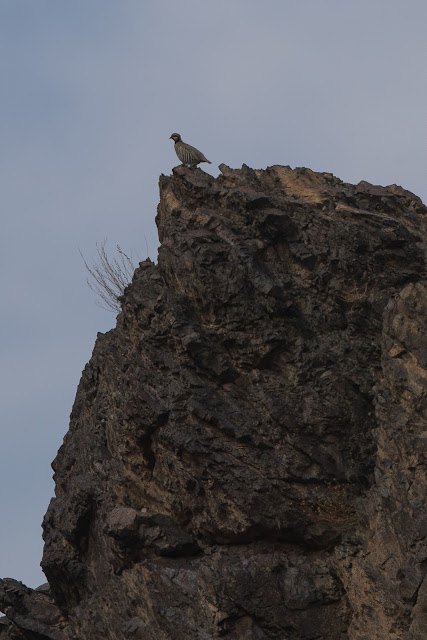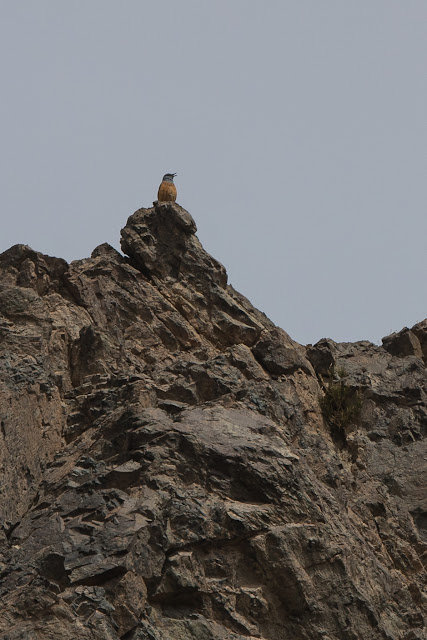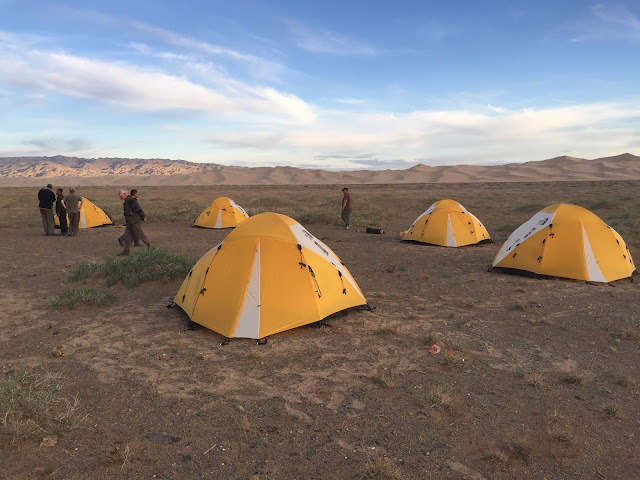We were up 05:45 and birded the habitat around the guest house. There had evidently been a small fall of migrants and we recorded six Eye-browed Thrush, three Pallas’s Bunting, 12 Red-throated Thrush, Dusky Warbler, Reed Warbler and, best of all, two Siberian Rubythroat which showed well in a newly planted line of scrub opposite the guest house and attracted to the irrigation system in place.
After breakfast we packed our bags and headed to an area of sparsely vegetated gravel plain just outside of Dalanzagad, here after driving across the plain for around 30 minutes we came across a pair of Oriental Plover. We watched the male for around 30 minutes in his fantastic display flight over the desert banking and flapping on long stiff wings while emitting a strange clicking call.
A female was also present here and, a little like Lapwing, the male seemed to display as a result of our presence as well as to impress the female. The display was reminiscent of the flight of a Leach’s Petrel or perhaps a Manx Shearwater.
Siberian Rubythroat – Dalanzadgad
Daurian Redstart – Dalanzadgad
White-cheeked Starling and Red-throated Thrush – Dalanzadgad
Oriental Plover
Female Oriental Plover
Oriental Plover, male in display flight
Oriental Plover, male over is desert habitat
We continued our drive eventually leaving the asphalt, a road surface we would not see for the next three days. We headed out through the Gobi Desert the landscape gradually becoming drier, flatter and stonier.
Stops along the way produced Steppe Eagle and Greater Sand-plover while Pallas’s Sandgrouse were regularly seen flying at speed along the roadside. We stopped at a small plantation consisting of a planted shelter belt and irrigated agricultural fields.
Here we recorded Pallas’s Warbler . Pallas’s Bunting , Little Bunting Dusky Warbler , Pin-tailed/Swinhoe’s Snipe and Wryneck .
Steppe Eagle
Steppe Eagle
Greater Sand-plover, male on territory
Dusky Warbler
Tolai Hare Lepus tolai
Pallas’s Bunting
Pallas’s Warbler
Daurian Redstart
Ger with all mod-cons
Driving onwards across gravel plains we came to a large wetland area, the water level was low and birds were very distant and in the heat haze not identifiable, we recorded Little Owl in a small barn, Taiga Flycatcher , Siberian Stonechat and Barry slipping on his arse and getting covered in mud and goat shit! Heading further west, we had great views of a pair of Mongolian Ground-jay adjacent to the road and found the birds nest.
Tussocky habitat close to a lake in the desert
Lake side vegetation and scenery
Lake and goats
Little Owl of raceplumipes
Mongolian Ground-jay
Mongolian Ground-jay
The Mongolian Ground-jay nest was located on the top of this bush which was
no more than 1.5m high
Mongolian Ground-jay nest and eggs
Mongolian Ground-jay nest
It was time for lunch and we headed up a ravine in the mountainside and found our lunch laid out for us in a spectacular ravine. While we ate we had great views of an adult Lammergeir plus Pied Wheatear , Chukar and Rufous-tailed Rockthrush.
Our lunchtime ravine
Lunch
Chukar
Rufous-tailed Rock Thrush
Female Pied Wheatear
Male Pied Wheatear
Male Pied Wheatear
Lammergeier
Following a dirt road west we drove parallel to the magnificent Khongor Sand Dunes the dunes progressively becoming larger and larger while backed by contrasting black and red rock mountains.
A short stop in an area of gravel desert with scattered scrub soon produced Asian Desert Warbler and we eventually obtained good views of these birds as they ran between scrub patches and occasionally sat-up to survey the surrounding land.
Greater Sand-plover
Asian Desert Warbler habitat
Asian Desert Warbler
Asian Desert Warbler
Asian Desert Warbler
Horned Lark nest and eggs
Desert habitat
The lower areas of the Khongor Sand Dunes
Desert Scenery
Our Russian support vehicle racing through the desert
Arriving at our camping area we birded an area of dunes and Saxaul Scrub where we had good views of Desert Wheatear and Hill Pigeon but Saxual Sparrow eluded us.
Our campsite over looked the Khongor Sand Dunes and we enjoyed a couple of beers overlooking the dunes watching a beautiful sunset and studying the moons of Jupiter.
Male Desert Wheatear
Female Desert Wheatear
The magnificent Khongor Sand Dunes
The magnificent Khongor Sand Dunes
Hill Pigeon
Hill Pigeon – Quite a distinctive bird when in flight
Hoopoe – Khongor Sand Dunes
Hoopoe – Khongor Sand Dunes
Red-cheeked Ground-squirrel Spermophilus erythrogenys- Khongor Sand Dunes
Khongor Sand Dunes
Desert ThumbCynomorium coccineum, said to cure erectile dysfunction and relished by our driver………
Our campsite at the foot of the Khongor Sand Dunes
My tent and the sunset
Sunset over the Khongor Sand Dunes
Simon Colenutt
I began birdwatching at the age of nine when living on the Isle of Wight. After obtaining a copy of the Isle of Wight Bird Report from 1976 I realised that Manx Shearwater, Arctic Skua, Pomarine Skua and Black Tern were regularly seen at St.Catherine's Point, only five miles from my home village of Chale Green. To a nine year old these birds were near mythical and so I just had to go and try to see them. Little did I know that these birds were seasonal and after a long winter of seeing nothing I eventually started to bump into other birdwatchers as March drew to a close. It was then that Dave Hunnybun, Dave Wooldridge, Paul Castle, Peter Gandy and Audrey Wilkinson introduced me to the art of seawatching and the joys of bird migration, I have not looked back since.



























































Leave a Reply